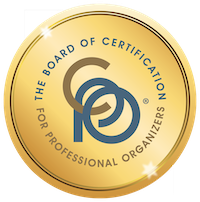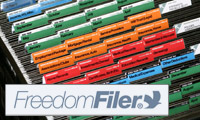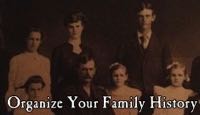Help for organizing your genealogy

Ten months ago, on June 14, 2012, I started a second blog, Organize Your Family History. It emerged from my interest in genealogy research and my desire to find a way to integrate my passion for this hobby with my organizing business. (One way I’ve done that is to introduce The Heirloom Explorer package
I don’t take starting a blog lightly. I think if you’re going to have a blog, you have to commit to writing posts. (I’ve written 737 posts on this blog, counting this one, since 2006.) So when I established Organize Your Family History I committed to blogging at least weekly. (I actually shoot for twice weekly, but don’t always get there.) One big benefit: Knowing that I need to blog helps me make time to do the actual family history research that fuels the blog.
In the blog, I write about dealing with the overwhelmed feelings that I have experienced with family history research. I write about ways to organize family history records. And I write about the challenges and triumphs of my own research. As with this blog, I just try to be authentic and write about what interests me, in hoping it will interest others.
If you are interested in family history research, I urge you to check it out. I also have a Facebook page for the blog and I’d love for you to like it!
Worth repeating: Self-care
I’m passionate about asking people to be kind to themselves and not let guilt about clutter (or anything else) get in the way of living their lives. It’s been almost six years since I wrote this post, called Self-Care, but it remains one of my very favorite posts. I thought I’d share it again today.
I’m always struck how clutter gets in the way of life. I have many clients who constantly feel an obligation to deal with their clutter. They plan to devote a weekend to decluttering, then they start to feel overwhelmed, so they don’t actually deal with it. (Until they call me.)
So for weeks, months, even years, they decline invitations to do fun stuff on their off hours because they should stay home and “get organized.” They don’t treat themselves to a movie, a vacation, or a bike ride because they feel an obligation to stay home and tackle what’s become for them a giant burden.
It breaks my heart.
I’m a big believer in self-care. Maybe because I don’t have kids and therefore have more free time than many women, I have no qualms about taking time away from the “shoulds” and enjoying myself. It happens that I’m easy to amuse—I’m thrilled to sit in front of a DVD of a favorite TV series and knit. That’s my idea of a great time. And I consider that self-care.
Last Sunday I spent the afternoon with some great women, chatting, laughing and doing crafts. Does my bathroom closet need sorting and purging? Oh yeah. It’ll get done some day. But I don’t let it get in the way of the very important hours in the day where I relax and enjoy myself. Getting together with my “craft sisters” nurtures me. And that’s really important.
If you’re reading organizing blogs because you’re feeling disorganized or frustrated by clutter, please don’t let it take over your life. If necessary, seek help (you can find a great organizer via NAPO’s website), and set aside time to work on your organizing project. The key is to actually do the work, rather than intending to do the work and being paralyzed in the process.
And then, please, find time to take care of yourself, rejuvenate your spirits and do something fun. Your idea of fun might be climb a mountain, like my amazing friend Shannon Wilkinson or it might be to take a bubble bath. Maybe you can make a list of things you’d love to do if you only finished getting organized. Then use the items on your list for rewards for the progress you make.
Don’t let clutter get in the way of life. Chip away at it, 15 minutes at a time. Then focus on some self-care. You’re worth it!
Time to downsize my purse
On Friday morning, I had a meeting with a bunch of professional organizers. The last time I met with this particular group, I was 15 minutes late. This time, I was bound and determined to be on time.
I was on my way out the door when I realized my car key wasn’t where it should be. Nor in the back up place. Nor anywhere else I could see. I stomped around the house looking for it, searched my voluminous purse, created chaos in the basket where we keep keys and finally threw in the towel and asked my husband if I could take his car.
I was 15 minutes late for my meeting. Not a great way to start the day.
An hour or so after the meeting, I glanced in my purse as I was zipping it and I saw the key glinting at the bottom. It was there all the time. (I really had searched my purse.)
That’s when I realized my purse is too big for my own good. It can be an organized purse. I use a Purse Perfector in it and everything has a place. (The car key never belongs in the main compartment of the purse…it has a special place in the outside pocket.) But because it’s so big, it’s easy for me to toss stuff in there and zip it up.
I’m not kidding when I tell you that about two weeks ago, I pulled a doorknob out of my purse. (That should have been a clue that it was time to downsize.)
So Saturday I pulled out my old, petite Butler Bag. (I blogged about my Butler Bag back in 2009.) I loved that bag, which has rigid compartments to hold things upright, but when I got an iPad, it was too small to accommodate it. So I upsized. Now, thanks to my fabulous iPhone and the fact that the iPad (the first generation) processes everything at a glacial pace, I don’t use the iPad. So I just needed my purse to accommodate my Kindle Paperwhite, which it does, if a little awkwardly.
Moving into a smaller bag meant that I had to make some tough decisions about what I’m going to carry around. But all the essentials fit nicely. And it’s virtually impossible to lose anything in there. (That said, I did manage to stash my watch in it, since I need to take it to be repaired.)
The new bag weighs a fraction of what the big bag weighed. I can easily find what I want. And I can’t introduce a bunch of new stuff (no more doorknobs). It’s a win-win.
Regifting
I know from working with clients that people have a very difficult time parting with items that were a gift.
When this comes up with clients, I always urge them to ask themselves whether the gift giver would want them to keep an item that they don’t use or love. (Usually the answer is no.) Then I encourage them to give the item to someone else. That someone else could be a stranger (via a charity) or someone they know.
Recently, I met my mother’s first cousin, Penny, for the first time. (We actually met once as kids, but that’s a dim memory.) I was traveling to western Missouri, so I contacted Penny, with whom I’d become reacquainted via email thanks to my genealogy blog. We arranged to spend the day together. (You can read about that fun family reunion on my genealogy blog, Organize Your Family History.)
As we were making the arrangements, Penny offered to regift something to me. She offered me an oil painting that was painted by my grandmother (Penny’s aunt).
To me, this is a perfect example of the power of regifting. Penny is moving and is starting the process of editing her belongings. My parents have my grandmother’s paintings and I imagine I’ll inherit at least one, but this is the first time I’ve been offered one.
Here’s the painting:

"Serenity is the Mood," by Sue Brown
The painting is not exactly my aesthetic. But it was painted my beloved grandmother, whose late-in-life love of painting was a big part of my childhood. I promptly hung it on the wall of one of my home offices. And I cherish it.
If you have items that you don’t cherish or use, but you’re hesitating to let them go because they originally came to you as a gift, please think about happy someone else might be to own that item.
I hereby give you permission to regift!
Storing tax documents
I filed my taxes last weekend. Once that was done, I had to deal with all the supporting documentation. I don’t like to spend much time organizing those papers because I fervently hope that I’ll never have to look at them again. (The only reason I can think of that I would is if I were audited.)
So I thought I’d outline the simple way I organize my business’s financial and tax documents.
I keep January through December files in a file box on the floor under my desk. As receipts and deposit slips come in throughout the year, I put them in the appropriate folder. Every month I reconcile them in Quickbooks.
Come tax time, I don’t need to look at the pieces of paper. All the data are in Quickbooks. So once I turned my taxes in, I just pulled all the paper out of all twelve of those hanging files and banded them together with a simple label.

The nifty rubberband is from Martha Stewart Home Office with Avery.
And then I put them in a file drawer in my basement, along with my copy of the tax return and other supporting documentation for our taxes. I write off a home office, so I separate out our utility bills throughout the year in the file cabinet where we store our personal finances. I put those in an envelope and add them to the file. In seven years, I’ll pull out all those receipts and supporting documentation and shred them. I keep the 1040s forever.
This filing takes virtually no time. I have the peace of mind of knowing where the taxes are if I should need them. And they’re in the basement, out of my work space.
I’ve been doing it this way for years and so far, knock wood, I haven’t wished I’d spent more time organizing!
Organizing wisdom from the Expo
As I’ve posted here, the St. Louis chapter of the National Association of Professional Organizers (NAPO-STL) sponsored an organizing expo for the public on March 23. It was over a year in the planning and all that planning showed. The event was a great success, with every detail anticipated. It ran so smoothly. I was extremely proud of our chapter. We had great participation!
The speakers were terrific. Over 100 audience members heard five great talks. (I was honored to be one of the speakers, covering garages and basements.)
Here are some of the nuggets I gleaned, one per speaker. (I included one of my own for the sake of completeness.)
- When you’ve decided to discard a piece of paper, tear it in half so that you don’t have to rethink that decision. — Julie Hough, The Ordered Home
- As far as the IRS is concerned, there’s nothing special about scraps of paper. Electronic/scanned documents work just as well. — Carolyn Conboy, Org4U
- Start small when deciding where to start decluttering. A single shelf, a single drawer or cupboard, something doable. And make it an area that’s high impact, if possible. — Janine Adams, Peace of Mind Organizing
- If an app doesn’t work for you, delete it. — Jennifer Stewart, Organizing by Jennifer
- Goals need to be reasonable or they’ll make you feel like a failure. If a goal is too aggressive for your best friend, it’s too aggressive for you. — Denise B. Lee, Clear Spaces LLC
Incidentally, I created a garages and basements Pinterest board to share some organizing solutions for those areas. If you have a garage or basement in need of organizing, you might want to check it out.
Simplicity to the extreme
The current (April 2013) issue of Martha Stewart Living features an article about Bea Johnson and her family. This family of four—Bea, her husband, and two school-age sons—embraces simple living and reducing waste to the point that they produce two handfuls of trash each year.
That was enough to make me sit up and take notice.
I wish the article, written by Rory Evans, went into more depth on Bea’s strategies. But what’s there is very interesting. The good news is that Bea Johnson has written a book, called Zero Waste Home: The Ultimate Guide to Simplifying Your Life by Reducing Your Waste, due out April 9.
Here are some nuggets (and photos) from the article:
- Forget about multiples. Each family member in her house has two towels.
- Eschew fashion trends. Her trend-free wardrobe fits in a carry-on suitcase (!) and all pieces go with one another. Check out her closet:

- Use your own reusable containers. According to the article, Bea brings her own containers when she shops, so she’s not bringing home disposable ones. She buys spices and pantry items in bulk and used her own glass containers to store them beautifully, as evidenced by these photos:


All I can say is wow. I look forward to checking out her book. That level of simplicity sounds a bit more spartan than enjoyable to me, but I admire the philosophy and effort behind it!
All photos by Laura Flippen, provided by and used with permission of Martha Stewart Living Magazine.
Links
- Ravelry
- Peace of Mind Spending
- Shannon Wilkinson, life coach
- National Association of Productivity and Organizing Professionals
- Getting to Good Enough podcast
- Are you interested in becoming a professional organizer?
- Organize Your Family History
- NAPO St. Louis
- Institute for Challenging Disorganization








